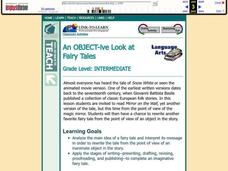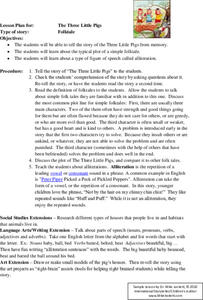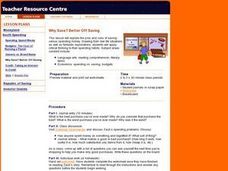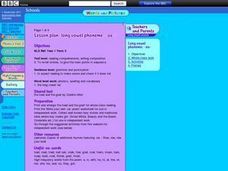Curated OER
The Learning Network: Re-envisioning Classic Stories
Readers reflect on enjoyable stories they know, brainstorm criteria that make a story "good," analyze a New York Times article about innovative children's performances, re-envision classics on their own, and peer edit drafts. Use this as...
Curated OER
Through the Eyes of the Big Bad Wolf
Imagine how the wolf would tell the tale of Little Red Riding Hood or The Three Little Pigs. Young writers re-imagine classic tales by adopting the point of view of another character in the story. After reading models like The True Story...
Curated OER
Fairy Tales
Students explore fairy tales. In this fairy tales lesson, students analyze the main idea of a fairy tale and interpret it. Students then re-write the story from the point of view of another character or object in the story.
Curated OER
Fairy Tales, Past and Present
Students examine the different elements of a fairy tale. They discover why setting, characters, problems and solutions are important in a fairy tale. They recreate the fairy tale in modern times and create a storybook to accompany their...
Curated OER
Cinderella Folk Tales: Variations in Plot and Setting
Students examine plot and setting of Cinderella, and how it changes as it is translated into different cultures, discuss universal literary elements of the Cinderella story, and write narratives with original settings and plots...
Curated OER
Fairy Tales
Students listen as the teacher reads fairy tales to students and identify patterns. They listen as the teacher re-reads the fairy tales and signal or recite patterns as they listen. Students identify patterns in the fairy tales. They...
Curated OER
Re-telling The Tale
Students retell a fairy tale by writing on the computer. In this writing lesson plan, students draft, revise, edit, and publish their retelling of the story.
Curated OER
Where Do We Begin?
Primary learners grasp sequence of events by discussing morning routines and reviewing the story of Little Red Riding Hood. They explore the necessity of correct order of events. As a class, create a story with a beginning, middle, and...
University of North Carolina
Literature (Fiction)
An informative installment of the Writing for Specific Fields series helps readers learn how to interpret and write about fiction. The website details nine easy steps for writing a literary analysis—a useful method for all readers!
Curated OER
The ea and ear sounds
Focus on the /ea/ and /ear/ sounds. Learners complete three sentences by adding the appropriate ea word from a word bank, re-writing each sentence. Then, they read an excerpt from Little Red Riding Hood and find all the...
Curated OER
Clay Heads
Sculpting can be a rewarding way to accent a lesson in any subject. This project requires learners to design and sculpt a head out of clay. The entire process is outlined in this resource; including photos and suggested materials. Tip:...
Curated OER
Examining Persuasive Literature
Examine persuasive literature and writing. In this persuasive literature lesson, pupils work through a variety of activities over the course of three weeks (each week is planned by day). The unit's purpose is to examine examples of...
Stephen F. Austin State University, College of Fine Arts
The Ugly Duckling
It's not about what you look like on the outside! A study guide for the stage adaptation of The Ugly Duckling reminds learners that being cruel to those in need is not helpful—and that we all belong somewhere.
Curated OER
Into the Wild
Students study about how sequels are created by using a well-known fairy tale to create their own. They choose a fairy tale, make a list of all the characters in the story, and generate 3 ideas (minimum) per character. They each select...
Curated OER
Catch Me If You Can: Over and Under
Students read a story. In this vocabulary skills lesson, students read The Gingerbread Man, use flannel cut outs to re-enact the gingerbread man running over and under.
Curated OER
The Three Little Pigs
Students read the story The Three Little Pigs and complete language activities about them. In this The Three Little Pigs lesson plan, students research houses, draw houses, and write alliteration poems.
Curated OER
Persuasion
Students read various stories and write reflections in their journals. Using the text, they identify the techniques the characters used in persuading the reader or other characters in the story.They rewrite a fairy tale from the villains...
Curated OER
Why Save? Better Off Saving
Students examine the pros and cons of saving versus spending money and evaluate real-life situations as well as their own spending habits. They discuss the best and worst purchase they have made and why, explore the "Downtown...
Curated OER
Cloudy With a Chance of Meatballs
Fourth graders participate in a play to work on seeing events from a different perspective. Some of them are reporters, some cameramen and women, and others are interviewed. They put themselves in the shoes of the people in the book...
Curated OER
Lesson Plan: Long Vowel Phoneme "oa"
Students read The Toad and The Goat, discuss main idea and story sequence, and identify rhyming words with the "oa" sound.
ReadWriteThink
Read Write Think: Fairy Tales From Life
A guideline for helping students to write their own fairy tales. This is a fun activity that will help students to analyze a literary style and follow a pattern.






















